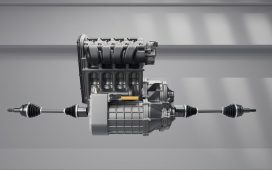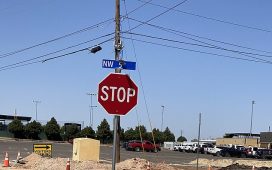James Dobson
(Missoula Current) On a cold November morning, Aaron Wilson was pedaling his bike across the Orange Street Bridge when a car sped by, nearly clipping his handlebars. Wilson didn’t flinch, because he makes this commute twice a day, five days a week.
“I guess that was pretty close,” Wilson said. “I’ve been doing this so long that I guess my risk-aversion is pretty low.”
This morning, Wilson is sporting fluorescent gloves with matching neon sunglasses. Rolling up his jeans to keep them out of puddles, he shows off socks that feature bright yellow stars.
Wilson, 42, looks like he should be riding to a hip coffee shop, not his office at City Hall.
Wilson is a transportation planning manager with Missoula’s Public Works and Mobility department, the team that dreams up how to make it safer for people to get around the city.
To get to Wilson’s office you first have to pass by the suits and briefcases of accounting and law before heading into the basement, but once you’re there, the entire vibe changes.
Framed art hangs next to cat memes. Coworkers are overheard having a heated discussion about the best practices for keeping a bike clean through winter. Wilson takes off his bike helmet and sits at his computer, surrounded by 14 potted plants.
On Friday’s agenda, Wilson is scheduled to meet with the heads of several city departments to discuss the prioritization of $245 million worth of infrastructure improvements detailed in the Long-Range Transportation Plan.
Aaron Wilson, a transportation specialist for the city of Missoula, attends a virtual meeting in his office in Missoula City Hall Friday, Nov. 15, 2024. (James Dobson/Missoula Current)
City Hall Friday, Nov. 15, 2024. (James Dobson/Missoula Current)
In its current phase, planners are choosing which projects should move forward. Sifting through 193 projects that cover 209 miles of the city, they’ve narrowed it down to 14 “highly likely” projects and 21 “likely” projects. The projects vary in scope and expense, from restriping road paint that expands a bike lane to building a new bridge across the Clark Fork River.
During the meeting, some attendees expressed worry about high prices for projects, but Wilson assured them that the planners were maximizing value wherever possible.
“A lot of these projects are already funded,” Wilson said. “There is a lot of desire about improving current connections.”
Transportation planning philosophy
There’s the sense that Wilson lives for the work of making Missoula safer. His Ivy-league diploma sits on the office floor while pictures of his partner and dogs are displayed proudly on his desk.
Originally a biologist who studied wildfire behavior, Wilson switched to urban planning in 2010 when he realized cities were their own kind of ecosystem.
“There’s all of these interconnected modes of how people move around,” Wilson said. “There’s a lot of problem-solving in this field, and I love how every day is a little different.”
Wilson says many of the problems that need solving recently come from safety issues surrounding the main arteries through town – the Reserve, Brooks and Russell corridors.
According to the Missoula Police Department, in 2023, there were 2,742 traffic accidents in the city, most of which were along these roads.
In response to this, the Missoula Metropolitan Planning Organization, City of Missoula, and Montana Department of Transportation launched the Reserve Street Safety Action Plan, studying the problem and asking for public input on how to best organize projects. This plan will integrate with other safety projects in the city, including Transform Brooks – Connect Midtown and Downtown Safety and Mobility (SAM) plans.
Wilson said smart urban planning not only makes roads safer, but also easier for people to walk, bike or ride the bus. He added that the hardest part of messaging these projects is that in a car-centric space like Missoula, the addition of bike lanes can be seen as a war on cars.
“People in general perceive transportation projects as an either/or,” Wilson said. “They see investments in other modes as taking away from theirs. It’s not bikes versus cars. We are trying to make it work for everyone.”
Traffic cues at an intersection on Reserve Street.
Transportation planners say one solution to make commuting work for everyone is building complete streets, roads with curbs that separate bike lanes from car traffic. Wilson said that this design helps drivers feel more comfortable passing cyclists and cyclists can relax on their commute. This design also is easier to maintain in the winter, with less snow being pushed by cars into the bike lane.
Wilson knows a thing or two about bike commuting in the snow. He said that he rides year-round, only taking the bus when it’s the coldest days of the year.
“I bike every day because I love it,” Wilson said. “It can be invigorating commuting in the winter. I feel proud of myself and ready for the day.”
Many of the projects likely to be recommended in the Long-Range Transportation Plan will include improvements for winter cyclists. Multimodal improvements to Higgins Avenue and converting Front and Main streets to two-way traffic will likely feature dedicated spaces for bikes.
Some projects in the plan will be recommended only as “illustrative,” the term for a project that the community would benefit from but doesn’t currently have funding. This includes ambitious plans to connect Missoula to the Great American Rail Trail, a bicycle path that hopes to connect Seattle to Washington D.C.
Wilson said that Missoula’s roads are already getting congested, and as the city’s population continues to grow, the LRTP looks to keep traffic flowing for the next 20 years. That’s why he’s focusing on how to get people to consider other modes of transportation. If everyone decided to walk or ride to work just one day a week, congestion problems would likely be solved for decades.
“Trying to implement change on this scale is really hard,” Wilson said. “It requires a shift in thinking. Finding a new way to get from A to B is tough, but once they experience it first-hand, they are often sold on it.”









